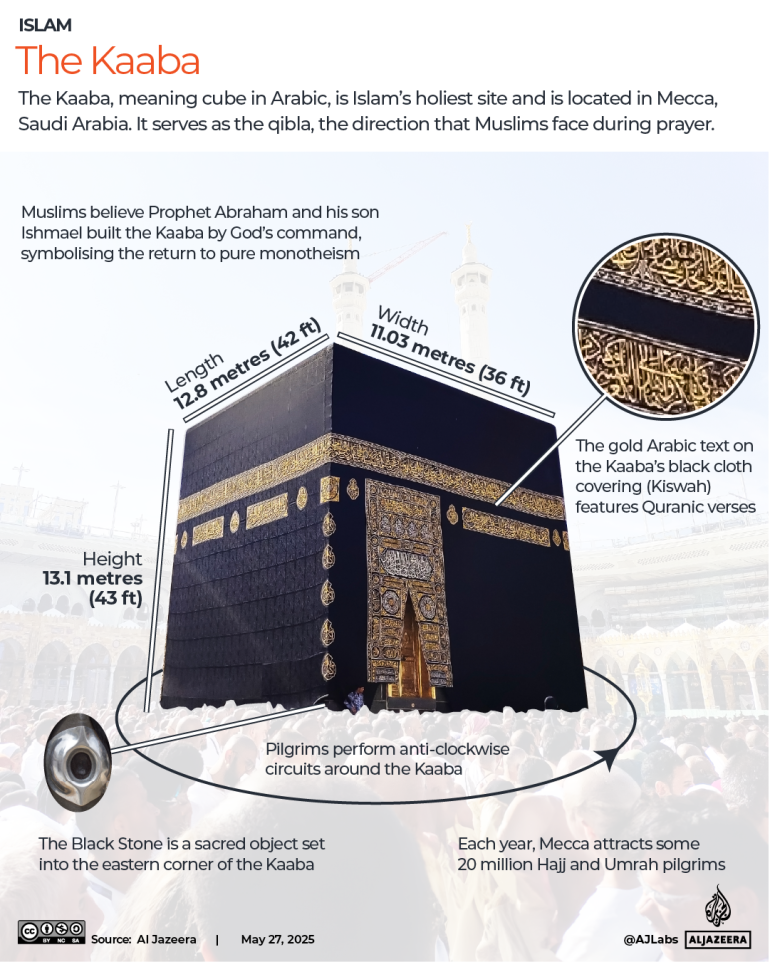As millions of Muslims from around the globe prepare for the Hajj pilgrimage in 2025, Al Jazeera has published a detailed visual guide explaining each step of the sacred journey in Mecca. The guide offers a comprehensive overview of the rituals, locations, and spiritual significance of Hajj — one of the five pillars of Islam and a once-in-a-lifetime obligation for all physically and financially able Muslims.
The pilgrimage officially begins on the 8th day of Dhul Hijjah, the 12th month of the Islamic calendar, and spans five to six days. The journey involves a series of profound rites that retrace the steps of the Prophet Ibrahim (Abraham), his wife Hajar, and their son Ismail (Ishmael), combining physical endurance with spiritual reflection.
Here is a summary of the key stages covered in the guide:
1. Ihram – The State of Spiritual Readiness
Pilgrims enter a sacred state known as ihram before crossing into Mecca. Men wear two white, unstitched cloths, while women wear modest, simple clothing. Physical grooming, arguing, and worldly distractions are prohibited, symbolizing purity and humility before God.
2. Tawaf – Circling the Kaaba
Upon arrival at the Masjid al-Haram in Mecca, pilgrims perform tawaf — walking seven times counterclockwise around the Kaaba, the cube-shaped structure believed to be the House of God. This rite represents unity and the centrality of faith in the lives of Muslims.
3. Sa’i – Walking Between Safa and Marwah
Pilgrims reenact Hajar’s desperate search for water by walking seven times between the hills of Safa and Marwah. The act commemorates her faith and endurance and is completed near the Zamzam well, where Muslims drink holy water believed to be divinely provided.
4. Mina – The Tent City
On the 8th of Dhul Hijjah, pilgrims travel to Mina, a sprawling tent city east of Mecca, where they spend the night in prayer and reflection. This marks the beginning of the formal Hajj rituals.
5. Arafat – The Day of Standing
The 9th of Dhul Hijjah is the pinnacle of Hajj. Pilgrims gather at Mount Arafat, where the Prophet Muhammad gave his final sermon. Standing in prayer from noon to sunset, they ask for forgiveness and reflect deeply, a moment many consider life-changing.
6. Muzdalifah – Under the Night Sky
After sunset, pilgrims move to Muzdalifah, where they pray and sleep under the open sky. They collect 49 or 70 small pebbles for the next day’s ritual, symbolizing preparation and discipline.
7. Rami al-Jamarat – Stoning the Devil
Pilgrims throw stones at three stone pillars in Mina, reenacting Ibrahim’s rejection of Satan’s temptations. This ritual, conducted over several days, symbolizes spiritual resistance against evil.
8. Eid al-Adha – The Sacrifice
Coinciding with the third day of Hajj, pilgrims participate in the sacrifice of an animal, honoring Ibrahim’s willingness to sacrifice his son in obedience to God. Meat is distributed to the poor, emphasizing charity and compassion.
9. Tawaf al-Ifadah – Another Circling of the Kaaba
Pilgrims return to Mecca to perform another tawaf, representing a renewed commitment to God. This rite is essential and marks the beginning of exiting the ihram state.
10. Farewell Tawaf – Final Ritual
Before leaving Mecca, pilgrims perform a final circumambulation of the Kaaba, known as the tawaf al-wada‘, bidding farewell to the sacred sanctuary.
Hajj 2025 is expected to draw over two million pilgrims. With its combination of spiritual discipline, collective worship, and physical challenge, the pilgrimage remains a powerful testament to Muslim unity and devotion.
Source; Al Jazeera



